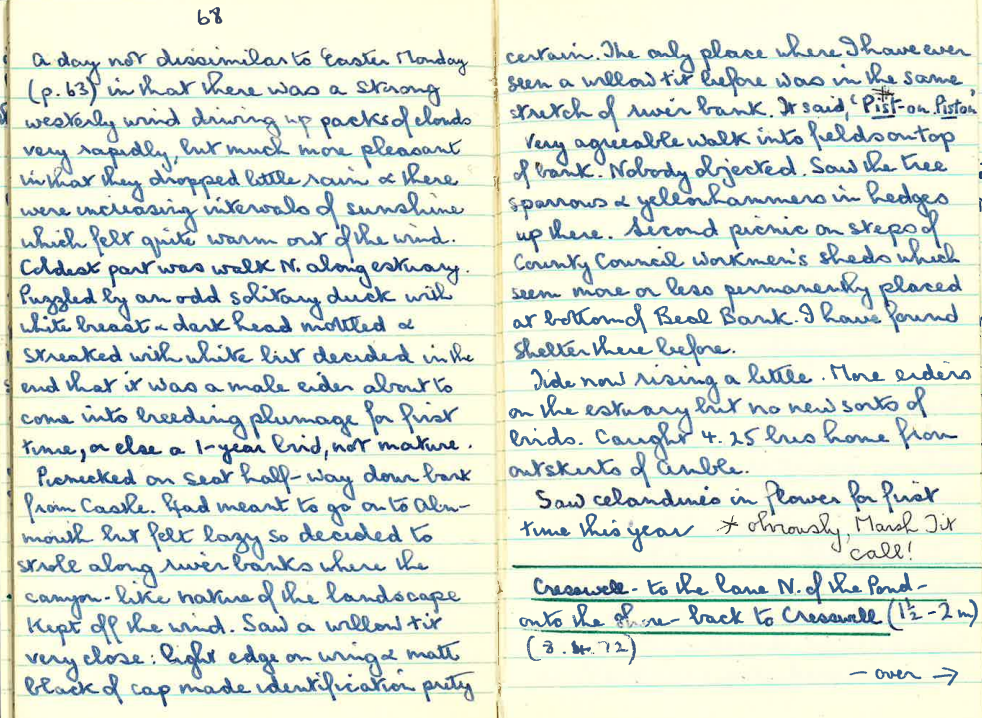North East Nature Archive Volunteer, Sue Vaughan, follows in the footsteps of ornithologist, Kathleen Barratt with a wildlife-filled trip along the Northumberland coast.
Kathleen Barratt was a member of the NHSN from 1953 until her death in December 2003. She was an avid amateur ornithologist keeping detailed handwritten diaries of her travels and bird sightings across Northumberland and further afield. NHSN’s North East Nature Archive holds over 30 of Kathleen’s diaries dating from 1960 – 1995 covering not only her bird sightings but observations of the weather, environment, travel and society of the time.
On 5 April 1972 Kathleen describes a walk from Amble to Warkworth as “a day not dissimilar to Easter Monday 1972 in that there was a strong westerly wind driving up packs of clouds very rapidly”. She goes on to say “the coldest part of the walk was north along the estuary”.


On 16th April I decided to follow in the footsteps of Kathleen and set out to take the X20 bus from Newcastle to Amble. This was a long, interesting and circuitous route through South East Northumberland.
Luckily I had wrapped up well because like Kathleen 52 years ago there was a strong, bitterly cold, headwind. With my head down and my list of Kathleen’s sightings, I walked along the estuary towards Warkworth. I was disappointed by the lack of bird life but not surprised due to the high tide and wind.
Instead, I noticed that there was bird life in the form of sculptures. These are part of a project called “Bord Waalk,” featuring artworks along the coast from Hauxley Wildlife Discovery Centre to Amble. Bord Waalk has its own app which describes the trail.
There are new signposts along the way indicating the England Coast Path a new continuous trail around the entire coast of England that encourages people to walk the coastline taking in nature that surrounds them.
At the top of the hill Warkworth Castle stands proudly surrounded by its daffodils which by now were fading but new plant life was emerging, Bluebells and Lesser Celandines. I wandered down towards the river and sheltered from the wind. By this time I had decided that perhaps I was not going to have a successful bird-watching day after all. To my surprise, I spotted a Mandarin duck and several male and female Goosanders!! These birds were not on Kathleen’s list.



Wandering further along I passed wild garlic in flower with its strong pungent smell. The path along the river is wide and if you turn around back towards Warkworth the view of the Castle is glorious.
I sat down on one of many benches and watched a group of Shelducks, numerous Cormorants diving successfully emerging with fish, gulping them down whole. I was kept company by two robins who were hopeful of being offered a few crumbs.
I passed opposite the Hermitage which is an English Heritage site and walked up the path Kathleen refers to as Waterworks Road. I discovered why when I hit the top of the hill to see a Northumbria Water sign stating it was Warkworth Water Treatment Works, a very modern-looking treatment plant can be seen across the field.
Returning along the estuary the wind had dropped, and the sun was shining. Birds had reappeared and I took time to sit inside the Dokies egg sculpture (Dokie being a northern term for a Guillemot) and immersed myself in the sight of Shelducks, Eiders, Redshanks, Whooper Swans, Oystercatchers, Turnstones, a Lapwing, Canada Geese, a Moorhen, terns and gulls.
Finally, it was time to return home, like Kathleen, on the bus, and sit back and reflect on the day. I had seen the same birds as Kathleen and had recorded a few additions to her list. The weather had been the same a cold biting wind, but so good to be outdoors. There are new things to see along the way now a sculpture trail with an App! new signs for the England Coastal Path Trail encouraging people to be out discovering nature.
I wondered “what would Kathleen think if she was here now?”